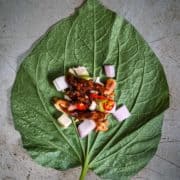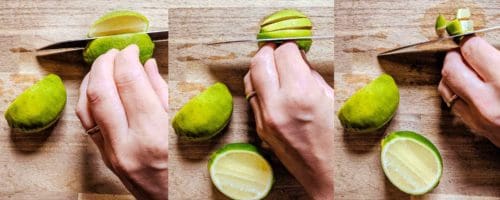Thai One Bite Leaf Wraps (Miang Kham เมี่ยงคำ)
To a certain degree the proportion of ingredients added when composing miang kam is down to to individual preference and imagination, so don't fret about exact measurements for the miang components. Some folks may wish to eliminate chillies while others may dislike the bitterness imparted by Persian lime rind (Thai limes—not makrut limes—are favourable but difficult to source outside the region). Should you wish to omit the lime pieces, try adding a tiny squirt of juice to the leaf or squeeze some directly into the sauce right before serving. Alternatively you can peel the whole limes before dicing them.
Ingredients
Nam Miang (the sauce)
- 90 grams shredded coconut (fresh or frozen) (1 packed cup)
- 20 grams small diced roasted galangal (2 tablespoons)
- 15 grams small diced mature ginger (1 ½ tablespoons)
- 15 grams sliced lemongrass (2 tablespoons). See notes1
- 25 grams roughly chopped shallot (2 tablespoons)
- ¼ teaspoon salt
- 2-3 teaspoons vegan shrimp paste, doenjang, or dark miso (Korean doenjang is best if you cannot source Thai vegan shrimp paste)
- 200 grams soft palm sugar (1 cup). See notes2
- 60 millilitres water (¼ cup)
- 1 tablespoon thin soy sauce see notes3
- 1 tablespoon tamarind paste see notes4
- 2 tablespoons ground toasted peanut
Miang components
- Cha plu Leaves see notes5
- The remaining toasted coconut from making the sauce
- ⅓–½ cup toasted peanuts
- ⅓–½ cup chopped ginger, peeled and cut into ½ centimetre pieces
- ⅓–½ cup shallot, peeled and cut into ½ centimetre pieces
- ⅓–½ cup ½ cm pieces lime
- 1-5 thinly sliced bird’s eye chillies (to taste)
Instructions
The sauce
- Heat a nonstick pan to medium low heat. Add the coconut and cook, stirring constantly, until browned (not burnt) and fragrant. 5-8 mins. Remove 3 tablespoons worth of the toasted coconut and pound with a pestle and mortar. Set aside the rest.
- Heat the same pan to medium. Add the galangal and ginger and cook, stirring continuously, until the colour begins to shift to a slightly darker shade and there is less sizzling. Add the lemongrass and shallot. Continue stirring to ensure even toasting. You’ll know it’s done when the the galangal, lemongrass, and ginger are mostly dried out. There might still be a little moisture left but that’s ok.
- Tip the contents of the pan, as well as the salt, into the mortar with the already pounded coconut. Pound with a pestle until you have a completely smooth paste. Finally, add the vegan shrimp paste (or miso) last and pound into a smooth amalgamation.
- Heat the palm sugar, water, and soy sauce together in a saucepan to medium high. Once the mixture begins to bubble, add the paste from the mortar and stir through to blend. Turn the heat down to around medium and simmer for about 2 minutes until the mixture cooks down a bit and has a slightly thick syrupy consistency. Turn the heat off, stir through the tamarind and ground peanuts, and set aside to cool to room temperature.
Assembly
- Quarter the lime by slicing lengthways, from stem to base, a bit off centre and close to the edge. The idea is to make four cuts around the edge of the lime, leaving a rectangular core, which you can chuck in a drink later. Take each slice, open side facing downward, and slice into approximate ½ centimetre slivers. Finally, cut these slivers again into approximately ½ centimetre cubes.
- Place the toasted coconut, peanuts, ginger, shallot, lime, and chilli on a platter or into small bowls alongside the wild pepper leaves.
- To assemble and eat the miang kham, lay a wild pepper leaf on the palm of your non-dominant hand. Use your other hand to add a pinch of each ingredient you’ve laid out above. Finally, crown the miang with a small dollop of the sauce. Bundle the leaf up by pinching the sides into a little parcel and pop the whole thing into your mouth. This is meant to be eaten in a single bite.
Notes
1. Peel any outer layers of papery skin from the lemongrass. Slice the lemongrass from the root end, only until you stop seeing purple rings. Save the remaining piece of the stalk for chucking in your tom yum or for making a sweet lemongrass drink.
2. I use Maesri brand palm sugar, which comes in a block. This is a soft palm sugar. You may need to make adjustments with other brands that contain less liquid (e.g. the solid pucks).
3. If you can use thin Thai soy sauce, that's great, but for this recipe anything will do. 4. How to make tamarind paste. 5. Cha plu leaves are most easily sourced from Thai or Vietnamese grocers. It's difficult to recommend a specific quantity of leaves because size varies so much, but the typical bags you buy in the UK will provide enough leaves for this recipe (perhaps with some leftover).
3. If you can use thin Thai soy sauce, that's great, but for this recipe anything will do. 4. How to make tamarind paste. 5. Cha plu leaves are most easily sourced from Thai or Vietnamese grocers. It's difficult to recommend a specific quantity of leaves because size varies so much, but the typical bags you buy in the UK will provide enough leaves for this recipe (perhaps with some leftover).

